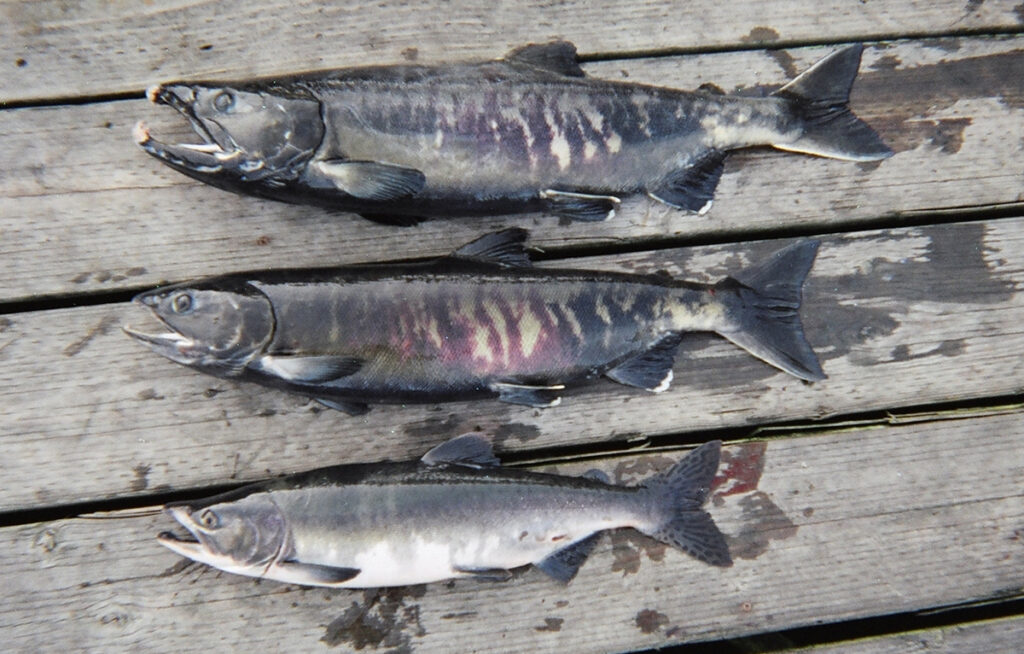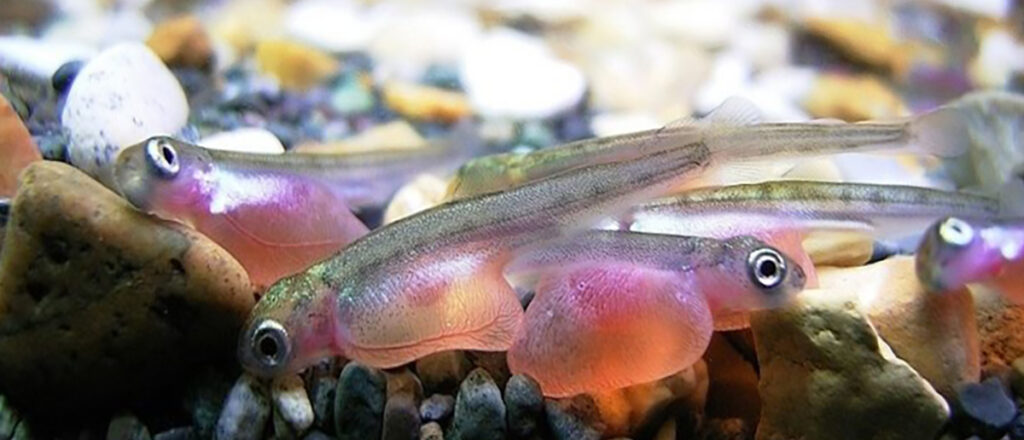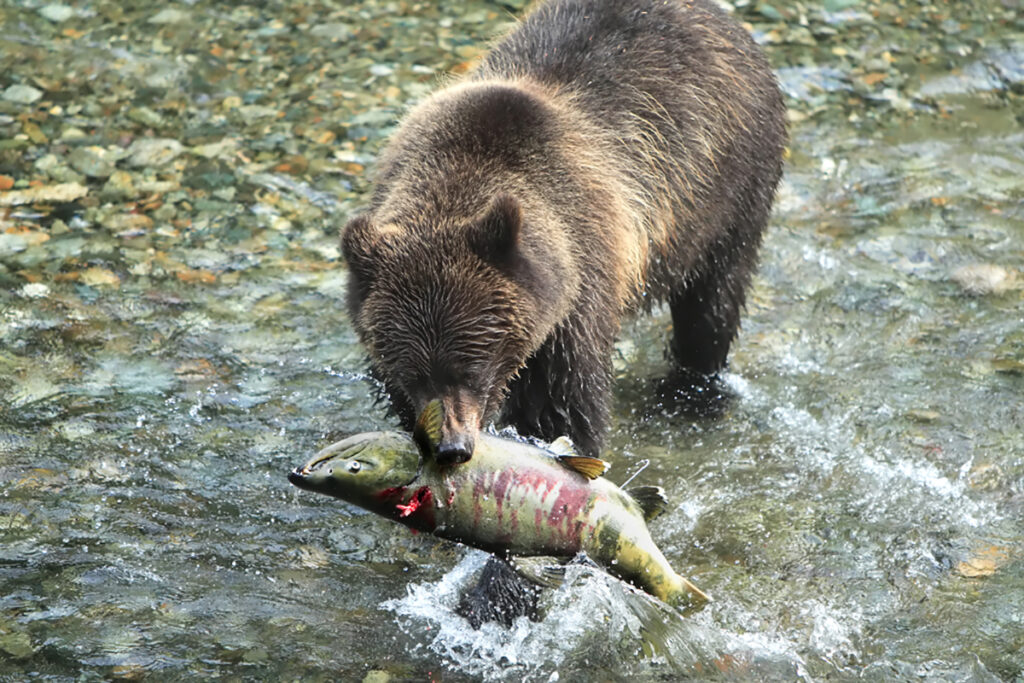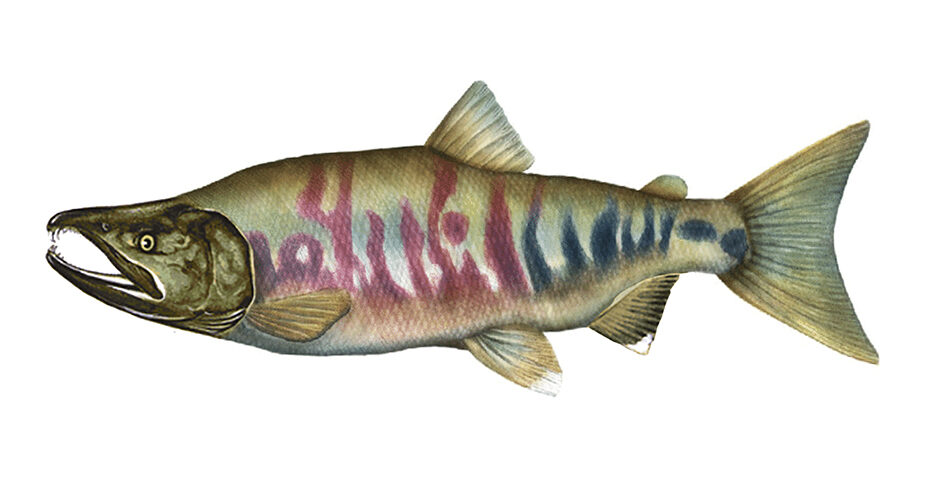Chum salmon are large, powerful fish with complex and unique life cycles. Regarded by some as inferior Pacific salmon, these underdogs persist in a hungry world. With a little knowledge about these salmonids, it’s hard not to feel admiration.
Sometimes called dog salmon, chum have loyally sustained ecosystems and communities for millennia. The page explores their life history, range, abundance, size, fisheries, and more.
Overview of Chum Salmon
The chum is a species of Pacific salmon closely related to pink salmon. It inhabits the North Pacific and parts of the Arctic Ocean from Asia to North America. Like its closest relatives, the chum dies after spawning (semelparous).
It undergoes the longest upriver migrations of Pacific salmonids but spends little time in freshwater as a juvenile.
Chum salmon flesh is also held in low regard, but their eggs are coveted.

Species and Name: Chum, Keta, Dog
Chum salmon, scientifically known as Oncorhynchus keta, are native to North America and Asia. The species ranges across multiple countries and is known by various names. The term “Keta” is derived from Russian. But it originated as a borrowed word from the Evenki people of present-day Russia and China, likely from the Amur River region.
The name “Chum” also has indigenous roots, originating from the Chinook Jargon word “tzum,” which means “spotted” or “marked.”
Another common name for chum salmon is “Dog salmon,” particularly in Alaska. There it’s frequently used as dog food. Mature male chum salmon are also distinguished by their large, canine-like teeth.
Additional names for this species include “calico salmon,” “shiro sake” (meaning “white salmon”) in Japan, and “damaha fish” in China.
Range and Abundance of Chums
Chum salmon live in both North America and Asia. They are the third most abundant wild Pacific salmonid species, following pink and sockeye salmon.
In North America, their range stretches from the Sacramento River in California northward. However, chums are relatively scarce in California, Oregon, and north of Norton Sound in Alaska.
In Asia, chum salmon are found west to the Lena River in the Arctic and south to Russia, Japan, and the east coast of Korea. They are the most abundant species of salmon in Japan.
Chum Salmon Size and Morphology
Chum salmon are large salmon. They average between 6.5 to 11 pounds (3-5kg). The current all-tackle IGFA world record chum salmon weighed 35 pounds (15.87 kg). It was caught in Edye Pass, British Columbia.
Subadult chum salmon have a silvery appearance without spots. Their tails possess an iridescent pigment in the form of rays. Additionally, they have a thinner caudal peduncle compared to other salmon species.
As they mature and enter freshwater, chum salmon turn olive green. They often display purple bars, which are darker towards the tail. Mature chum salmon also have white tips on their anal and ventral fins.
Mature males rapidly develop an elongated kype and enlarged teeth.
The Chum Salmon Life Cycle
Chum salmon are born in freshwater, migrate and grow at sea, then return to their river of birth to spawn and die. They share two defining features of Pacific salmon: anadromy and semelparity.
Anadromy is defined as fish born in freshwater, migrating to saltwater, then returning to freshwater to spawn. Salmon, sturgeon, and lamprey are examples of anadromous fish. Semelparity is death after the first reproduction.
Chum usually spawn in the lower reaches of rivers soon after leaving the ocean. However, some exceptional populations, like those in the Yukon and Amur rivers, embark on remarkable 1200+ mile (2000 km) journeys. There are also a few populations of chums that spawn on lake beaches.
Seasonal Runs of Chum
Chum salmon return to spawn at different times of the year. There are three distinct runs of chum. Summer and fall chum are by far the most common. Only one population of winter-run chum salmon persists, located in South Puget Sound.

Eggs and Emerging Fry
Chum salmon dig nests (redds) in gravel to deposit their eggs. About 3,000 large eggs are typical. Eggs will develop into alevin before eventually emerging in late winter in early spring.
Fry emerging fry measure between 32mm to 38mm. This is comparatively large among Pacific salmonids. During this stage, they exhibit small parr marks and elongated bodies.
Many chum salmon fry immediately migrate downstream to the sea. Some will instead spend a few days or weeks feeding in the river before beginning their journey. But overall, chum salmon spend little time in freshwater as juveniles.
Estuaries and Open Ocean
Chum salmon often spend a few weeks feeding in estuaries before migrating offshore. Among Pacific salmon and trout, this is a rapid migration from emergent fry to offshore.
Once they enter the open ocean, they continue their migration, adapting to various marine environments. Typically, chum salmon reach maturity between 3 to 5 years of age, although individuals living further north have longer lifespans.
Nearing maturity, chum will migrate back toward their natal streams. This homeward journey can span over a thousand miles. How chum salmon navigate back isn’t completely understood. But it’s likely a combination of celestial navigation, electromagnetic senses, memory, and eventually smell.

The Dog Salmon, Man’s Best Friend
I hope this page shows that the dog salmon is much more than a commodity. It’s a complex species vital to ecosystems across two oceans and continents. It has nourished communities for millennia, is incredibly productive where allowed, and is a top sport fishing target for anglers.
There aren’t a lot of fish like chum salmon. Despite so many things trying to eat them, they thrive.
Chum bring fertility from oceans to rivers, sustaining the landscape. The value they provide is deserving of praise.
